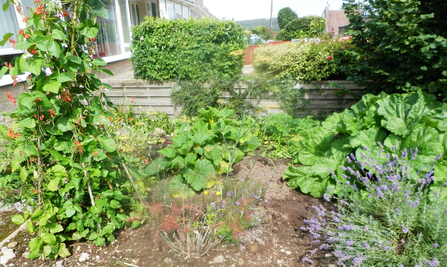
Part of Dyane's vegetable garden
Join by 30 January to get 3 months free membership!

Part of Dyane's vegetable garden
"It's difficult to mix crops and wildlife ... You need to use pesticides to stop the bugs eating your plants ... To feed the planet with organically grown produce would require more land than we have ... Herbicides are the only practical way to keep weeds down; weeding by hand is just too much work."
Really? Let's explore just a few of the ways that encouraging wildlife can actually benefit your vegetable garden, and without increasing the work you need to put in. Sometimes you can even do less!
Compost and leaf mould
The most obvious starting point is to grow crops that want to grow in your soil type and climatic conditions: make sure the soil is suitably fertile and your crops are watered: healthy plants are more resilient in the face of pests. Compost and leaf mould are easy to make yourself, and leaving comfrey to fester in a bucket of water results in an incredibly effective fertiliser. (It stinks, but believe me, it works: stir it up before adding a bit to your watering can, and add more water to the bucket each time you use some!) If you can manage to grow the comfrey in your garden you have a ready supply, and a pollinator-attracting plant.
Nurture pollinators
That attracting more pollinating insects will lead to more productive crops is basic sense. In using chemical pesticides you're not just killing the pests, but all the good insects too. The devastating decline in insect populations over recent decades has resulted in some farmers – largely in Asia – hand-pollinating their crops. Others are turning to technology and trying to develop swarms of robotic pollinators, but surely it's got to be easier to nurture the natural ones!
Attract pest predators
Intermingling your crops with plants that attract pollinators is a good idea too: plant aromatic herbs such as thyme, oregano and sage around the vegetable plot – they keep weeds down, and bees and hoverflies love them. Even letting one or two of crops such as carrots, parsnips and onions to flower will bring in insects (and give you the seeds for next year). Add to this a patch or two of weeds close by to provide shelter for predator insects such as ladybirds and lacewings which can then feed on any pest insects that do move in. Including “companion plants” (marigolds are supposed to be a good one) in your vegetable plot can be beneficial. These either deter pests – by their smell, usually – or attract them in preference to your veggies.
Keeping pests at bay
Of course it's good to keep the pests off your crops in the first place if you can: fine plastic (or wire) mesh over your vegetable plants will keep butterflies from laying their eggs on your cabbages but still allow bees and pollinating flies through. If you can keep most of them out, removing the eggs of the few that get through your defences is a much reduced chore. Scattering broken eggshells or coffee grounds around plants will deter slugs and snails. And both will decompose and enrich the soil too, so there's a double benefit.
Weed and hoe
If you're fairly serious about growing fruit and vegetables – and of course dependent on the size of your plot – it's often not such a huge job to pull out weeds by hand, or hoe the patch regularly to keep them in check. Nothing's entirely labour-free (not even going to the supermarket!).
I have no definitive proof that letting my lawn turn into a wildflower meadow this summer is connected to the particularly good crop of vegetables and soft fruit I'm seeing, but I shall definitely be trying it again next year.
All of that said, I will be deeply grateful to anyone who has a successful organic way to stop the woodlice from decimating my strawberry crop!